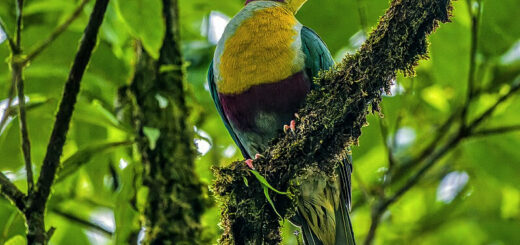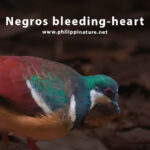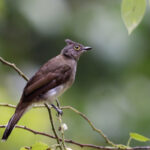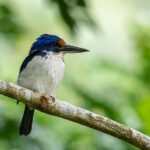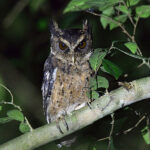The Unique Native Animals of the Philippines
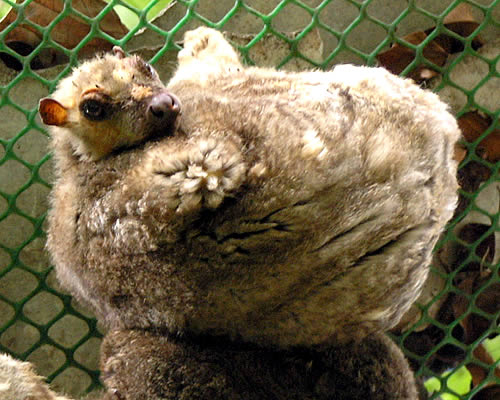
The native animals of the Philippines are not just a treasure trove of biodiversity; they are essential to the ecological health of the islands. As stewards of this unique environment, it is our responsibility to protect these species and their habitats for future generations. By supporting conservation efforts and raising awareness, we can help ensure that the incredible wildlife of the Philippines continues to thrive.
Here in Philippinature, we’ll explore some of the most fascinating native animals that call the Philippines home, showcasing their unique traits and the importance of conservation efforts.
Philippine Flying Lemur
Despite its name, the Philippine Flying Lemur (Cynocephalus volans) is not a lemur but a colugo. Known for its gliding abilities, this nocturnal creature has a membrane stretching from its neck to its fingertips, allowing it to glide between trees. Found primarily in the forests of Luzon and Mindanao, it plays an essential role in the ecosystem by dispersing seeds.Read more.
Pilandok – Philippine Mouse Deer
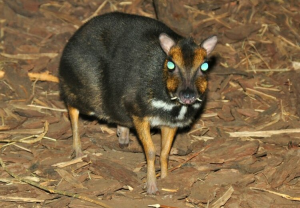
Wroclaw Zoo, Poland. Photograph by Klaus Rudloff [email protected] https://www.biolib.cz/en/image/id254762
Pilandok or Balabac Mousedeer belong to a very ancient line of hoofed animals, they are not actually deer, but belong to a group of their own, which is equally related to deer, pigs, cattle and other ungulates. The Pilandok is restricted to lowland forests of the Balabac group of islands in the very south of Palawan, where it is only recorded from Balabac, Ramos and Bugsuk. Since it is one of the most familiar wildlife species in this area, it has high potential to serve as flagship for the forest ecosystems of this island group. It was selected as flagship species of the Municipality of Balabac. Read More.
The Philippine Eagle
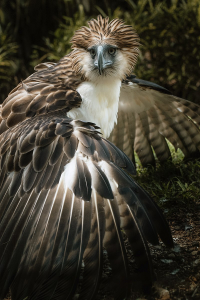
Photo from wikipedia – Shemlongakit
One of the most iconic native animals is the Philippine Eagle (Pithecophaga jefferyi), it was formerly known as the Monkey-eating Eagle, as reports from natives told that the raptor preyed exclusively on monkeys. This was later found to be incorrect as more recent studies have revealed the species to prey on a variety of animals ranging from rodents and bats to pigs and monitor lizards.” This majestic bird is one of the largest and most powerful eagles in the world, with a wingspan of up to seven feet. Found primarily in the forests of Luzon, Leyte, and Mindanao, the Philippine Eagle is critically endangered, primarily due to habitat loss and hunting. Conservation programs are crucial for their survival, focusing on habitat preservation and community education. Read more.
The Tarsier
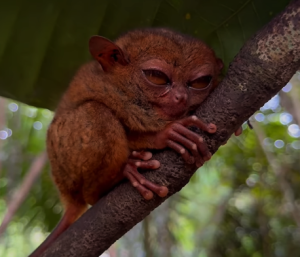
The Philippine Tarsier (Carlito syrichta) is a small primate known for its enormous eyes and unique ability to rotate its head almost 180 degrees. This nocturnal creature is primarily found in the forests of Bohol, Leyte, and Mindanao. Tarsiers are insectivorous and play a vital role in controlling insect populations. Sadly, they face threats from habitat destruction and the illegal pet trade. Conservation efforts are focused on preserving their habitats and promoting eco-tourism to raise awareness. Read more.
The Philippine Crocodile
The Philippine Crocodile (Crocodylus mindorensis) is a freshwater crocodile native to the Philippines. It is one of the most endangered crocodile species in the world, primarily due to habitat loss and hunting. With a more docile nature compared to its saltwater counterparts, the Philippine Crocodile plays a crucial role in maintaining the ecological balance in its freshwater habitats. Conservation programs aim to protect its remaining populations and restore its natural habitats. Read more.
The Palawan Bearcat
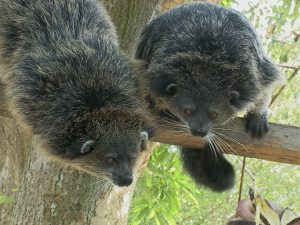
Photo from wikipedia -PCSD (Palawan Council for Sustainable Development)
Also known as the Binturong (Arctictis binturong), the Palawan Bearcat is native to the forests of Palawan. Despite its name, it is not a bear or a cat but a unique mammal that has a distinct appearance with a long, bushy tail and a shaggy coat. These animals are mostly arboreal and are vital for seed dispersal in their forest habitats. Unfortunately, they are threatened by habitat destruction and the illegal wildlife trade, making conservation efforts essential.Read more.
The Tamaraw
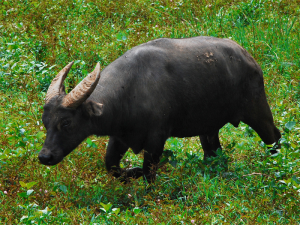
Photo credit @ Wikipedia Creator: Gregg Yan
Credit: Gregg Yan
The Tamaraw (Bubalus mindorensis) is a small, critically endangered buffalo species endemic to Mindoro Island. Once widespread, its population has dramatically decreased due to hunting and habitat loss. With its distinct curved horns and stocky build, the Tamaraw is a symbol of conservation in the Philippines. Efforts are underway to protect its remaining populations through habitat conservation and community involvement.Read more.
The Philippine Cobra
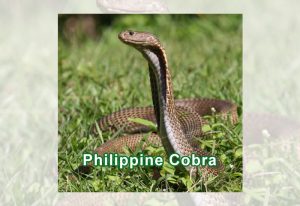
© Mario Lutz | Creative Commons
The Philippine Cobra (Naja philippinensis) is one of the most fascinating and feared snakes in the Philippines. Renowned for its potent venom and striking appearance, this snake plays a vital role in the country’s ecosystem. Read more.
Lawin
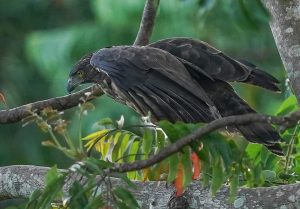
© Bim Quemado | fb/masungigeoreserve
The Lawin is a striking bird, characterized by its long tail and powerful build. Adult hawk-eagles typically exhibit a dark brown plumage with a white underbelly, adorned with dark streaks. Their eyes are sharp and yellow, reflecting their keen hunting prowess. Juveniles, on the other hand, display a more varied coloration, often featuring browner tones and lighter underparts, which provide effective camouflage in their natural habitat. Read more.
Philippine Giant Golden-Crowned Flying Fox
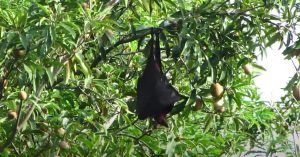
Philippine Giant Golden Crowned Flying Fox
© screengrab from youtube/Tambutsoo
The Giant Golden-Crowned Flying Fox is one of the largest bat species in the world. With a wingspan that can reach up to 5.6 feet and a body length of about 12 inches, weighing in at approximately 1.1 kilograms, this bat is truly a sight to behold. Its fur is a rich golden-brown, with a distinctive golden crown that gives it its name. This beautiful coat not only serves as camouflage among the treetops but also helps it maintain body temperature in its warm tropical habitat. Read more.
Turtle Species
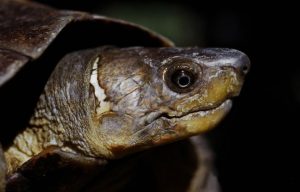
Philippine Forest Turtle
© Creative Commons | Author: Pierre Fidenci
The Philippines is a critical nesting ground for several sea turtle species, including the Green Sea Turtle (Chelonia mydas) and the Hawksbill Turtle (Eretmochelys imbricata). These turtles face numerous threats, including habitat loss, pollution, and illegal hunting. Conservation initiatives focus on protecting nesting sites and promoting marine conservation awareness among local communities. Read more.
Endemic Amphibians
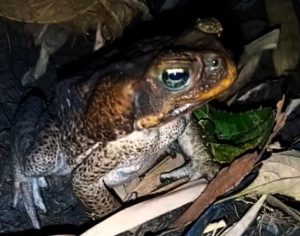
Giant Philippine Frog
© Youtube/Jandez Ga-ang
The Philippines is home to a plethora of endemic amphibians, including the vibrant Philippine Frog (Platymantis species) and various species of toads. These amphibians are often indicators of environmental health, making their conservation critical. Protecting their habitats is essential for maintaining the ecological balance in the region. Read more.
Conservation Challenges and Efforts
The native wildlife of the Philippines faces numerous threats, primarily due to deforestation, habitat destruction, and the illegal wildlife trade. Conservation organizations, government agencies, and local communities are working together to combat these issues. Initiatives include:
Protected Areas: Establishing national parks and protected areas to safeguard critical habitats.
Community Education: Raising awareness among local communities about the importance of biodiversity and sustainable practices.
Eco-Tourism: Promoting responsible tourism that benefits both wildlife and local economies.
The native animals of the Philippines are a testament to the country’s rich biodiversity. However, many of these species are facing significant threats due to habitat destruction, climate change, and illegal hunting. Conservation efforts are vital to ensure that future generations can experience and appreciate the unique wildlife that this beautiful archipelago has to offer.
By raising awareness and promoting sustainable practices, we can help protect the Philippines’ incredible native animals and their habitats for years to come. Whether you’re a nature lover, a conservationist, or simply curious, the Philippines’ wildlife is sure to inspire and amaze!
References:
https://en.wikipedia.org/wiki/Philippine_flying_lemur


